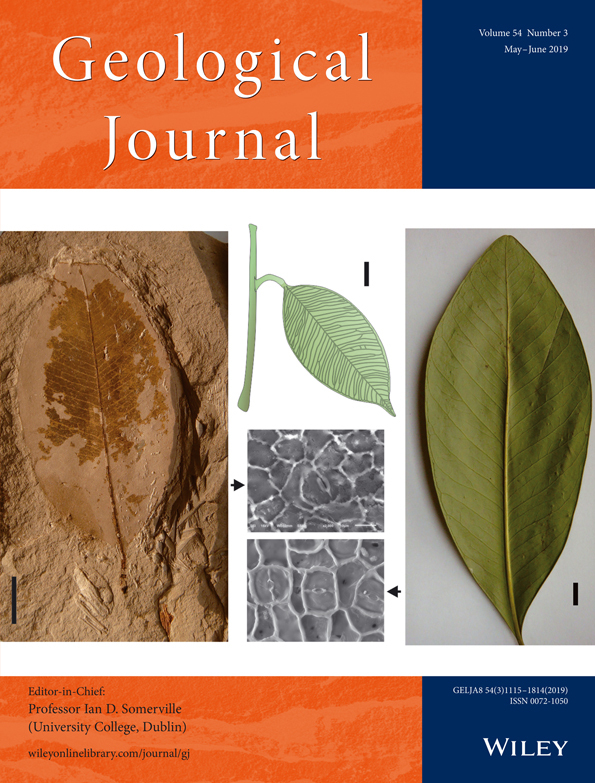Mississippian lithofacies and foraminiferal biozonation of the Alborz Mountains, Iran: Implications for regional geology
Abstract
The Mississippian rocks at 5 sections, Kalariz, Peyghambaran, Jaban, Naserabad, and Dozdehban, have been measured and sampled in a SE–NW direction across the Alborz Mountains. Foraminiferal zones recognized in those sections, as well as a revision of other foraminiferal assemblage previously published from the Alborz Mountains, allow to recognize 12 biozones: 5 in the Tournaisian: Unilocular (MFZ1–MFZ2? interval), Septabrunsiina krainica (MFZ3–MFZ5 interval), Eotextularia diversa (MFZ6), Darjella monilis (MFZ7), and primitive Eoparastaffella (MFZ8); 5 Viséan biozones: Eoparastaffella simplex (MFZ9), primitive archaediscids (MFZ10), Uralodiscus rotundus (MFZ11), Pojarkovella–Koskinotextularia (MFZ12), Neoarchaediscus (Upper Mikhailovian), Howchinia gibba–Archaediscus/Paraarchaediscus at angulatus-tenuis stage–Neoarchaediscus akchimensis (Venevian substage); and 2 Serpukhovian biozones: Biseriella parva–Climacammina (Tarusian–Steshevian substages) and Turrispiroides multivolutus–Brenckleina–Eostaffellina protvae (Protvian substage) for the Mississippian rocks of Alborz. Analysis of foraminiferal assemblages indicates a noticeable age difference of the Mississippian rocks between the northern and southern flanks of Alborz. Accordingly, south-eastern and east-central Alborz (Kalariz, Peyghambaran, and Jaban sections) display complete Tournaisian deposits (MFZ1–MFZ8), whereas northern Alborz contains the strata dated from Late Tournaisian to Late Serpukhovian (MFZ8–MFZ16). The sedimentological studies also reveal sharp facies variations following the mentioned age variation. Previously, the age variations of these rocks were attributed to various events, such as the Mississippian glaciation phases. However, the age, facies, and thickness variations of lithostratigraphic units in the Alborz are not specific to the Mississippian and are reported during the entire Palaeozoic and even Mesozoic and Cenozoic. They can rather be attributed to the inherited basement and syn-sedimentary E–W-trending faults.
1 INTRODUCTION
The Alborz Mountains have attracted for a long time the attention of stratigraphers and palaeontologists for relatively rich fossiliferous, complete successions ranging from the Neoproterozoic–Cambrian (Brasier et al., 1990; Etemad-Saeed et al., 2016; Hamdi, Brasier, & Zhiwen, 1989), Ordovician–Silurian (Jenny, 1977; Popov, Bassett, Holmer, & Ghobadi-Pour, 2009), Devonian–Carboniferous (Alipour, Hosseini-Nezhad, Vachard, & Rashidi, 2013; Habibi, Corradini, & Yazdi, 2008; Vachard, 1996), and Permian (Angiolini, Checconi, Gaetani, & Rettori, 2010; Gaetani et al., 2009; Zandkarimi, Najafian, Bahrammanesh, & Vachard, 2014) through Mesozoic (Fürsich, Wilmsen, Seyed-Emami, & Majidifard, 2009; Seyed-Emami, Fürsich, Wilmsen, Schairer, & Majidifard, 2005) to Cenozoic (Mehr & Adabi, 2014). The Alborz Mountains are also of high potential for researches on the active tectonics and seismology (Asiabar & Bagheriyan, 2017; Berberian, Qorashi, Jackson, Priestley, & Wallace, 1992; Berberian & Walker, 2010; Ehteshami-Moinabadi, 2014; Ehteshami-Moinabadi & Yassaghi, 2007; Ritz et al., 2006) and Palaeo-Tethys evolution (Alavi, 1991; Rossetti et al., 2017; Şengör, 1990; Zanchetta, Zanchi, Villa, Poli, & Muttoni, 2009; Zanchi, Berra, Mattei, Ghassemi, & Sabouri, 2006).
The Mississippian deposits of the central Alborz are classified into the Mobarak and Dozdehban formations; the former is exposed in all the Alborz range, whereas the latter is solely observed in central Alborz. The Mobarak Formation was introduced by Assereto (1963) in the Mobarakabad area, central Alborz, and comprises black fossiliferous limestone with subordinate black marl in the lower part. It has been widely studied and dated in central Alborz using brachiopods (Bahrammanesh, Angiolini, Antonelli, Aghababalou, & Gaetani, 2011; Gaetani, 1964, 1965, 1968; Qiao, Falahatgar, & Shen, 2017), conodonts (Ahmadzadeh Heravi, 1971; Habibi et al., 2008), and foraminifers (Bozorgnia, 1973; Devuyst & Kalvoda, 2007; Falahatgar, Vachard, & Sakha, 2015; Vachard, 1996; Zandkarimi, 2017; Zandkarimi, Najafian, Vachard, Bahrammanesh, & Vaziri, 2016; Zandkarimi, Vachard, Cózar, et al., 2017; Zandkarimi, Vachard, Najafian, Hamdi, & Mosaddegh, 2017). The Mississippian of the north-eastern Alborz in addition to the Mobarak Formation contains relatively similar strata to the Dozdehban Formation, which was referred to as the “Bagherabad Formation” (Leven & Gorgij, 2011; Lys, Stampfli, & Jenny, 1978).
For a synthesis of the Mississippian foraminiferal zonation and Late Palaeozoic stratigraphy of Alborz, we have followed the works of Assereto (1963), Bozorgnia (1973), Stöcklin and Setudehnia (1991), Vachard (1996), Brenckle, Gaetani, Angiolini, and Bahrammanesh (2009), Falahatgar et al. (2015), Zandkarimi et al. (2014), Zandkarimi et al. (2016), Zandkarimi, Vachard, Cózar, et al. (2017) and Zandkarimi, Vachard, Najafian, et al. (2017), and several unpublished MSc and PhD theses (Bastami, 2017; Mosaddegh, 2000; Najafi, 2001; Payami-e Rad, 2012; Zandkarimi, 2017) carried out on the Late Palaeozoic of Alborz, and for foraminiferal classification and correlation of zonation with well-known Mississippian references, we have followed the works of Pirlet and Conil (1977), Vachard and Tahiri (1991), Vachard and Berkhli (1992), Hance, Hou, and Vachard (2011), Gibshman (2001, 2003), Gibshman, Kabanov, Alekseev, Goreva, and Moshkina (2009), Nikolaeva, Kulagina, Pazukhin, Kochetova, and Konvalova (2009), Kabanov, Alekseev, Gibshman, Gabdullin, and Bershov (2016), Vachard (2016), and various papers of Cózar and Somerville (2004, 2005, 2012, 2014, 2016), Somerville (2008), Cózar, Somerville, and Burgess (2008, 2010), Cózar, Somerville, Aretz, and Herbig (2005); Cózar et al. (2011), Cózar et al. (2014), Cózar, Sanz-López, and Blanco-Ferrera (2015), and Cózar et al. (2016). The microfacies and depositional interpretation follow the works of Dunham (1962), Read (1982), Burchette and Wright (1992), Mosaddegh (2000), and Flügel (2004).
The aims of this study are (a) to establish a more comprehensive biozonation for the Mississippian rocks of the Alborz, (b) to provide more information about lithostratigraphy and lithofacies of the abovementioned rocks, and (c) to discuss about the possible causes of the variations of ages, lithologies, and facies of the Mississippian rock units throughout the Alborz.
2 GEOLOGICAL SETTING
The Alborz Mountains, one of the major tectono-sedimentary units of Iran, located in northern Iran form a high arc of mountains with pronounced topography around the southern coast of the Caspian Sea, from Talesh in the west to Kopeh-Dagh in the east (Berberian, 2014). The evolution of the Alborz Range in the Palaeozoic was under control of the opening and closure of the Palaeo-Tethys Ocean (Alavi, 1996; Arefifard, 2017; Berberian & King, 1981; Stampfli, 1978). During northward subduction of the Palaeo-Tethys Ocean, the Alborz experienced a passive continental margin setting. The collision of Iran and other “Cimmerian” blocks with southern Laurasia (i.e., Turan Plate) resulted in the Eo-Cimmerian Orogeny (Berberian & King, 1981; Zanchi et al., 2009), which led to the final closure of the Palaeo-Tethys Ocean and Eo-Cimmerian Orogeny in the Alborz Range. It is believed that the main effective events forming this range are Middle Triassic Eo-Cimmerian Orogeny and subsequent Cenozoic tectonic events (Alavi, 1996; Allen, Ghassemi, Shahrabi, & Qorashi, 2003; Ehteshami-Moinabadi, Yassaghi, & Amini, 2012; Zanchi et al., 2009). The Alborz Mountains were divided by Stöcklin (1974) into several subzones of the Gorgan Spur, northern Neogene, north-central, south-central, and southern Tertiary, and southern frontal uplift zones, which are limited by major and thrust faults. Tectonic boundaries of the Alborz are poorly defined (Aghanabati, 2004, 2009; Alavi, 1991). As a result, some researchers consider even Azerbaijan as a western continuation of the Alborz (Alavi, 1991; Nabavi, 1976), whereas others have the opinion that it is confined to the western Caspian Sea (Berberian, 2014; Zanchetta et al., 2009; Zanchi et al., 2006). According to the opinion of the latter group of authors, the Alborz is bounded to the north and north-east by the Palaeo-Tethys collisional suture zone (Alavi, 1996), to the north-west by the Caspian Depression, and to the east by the Kopeh-Dagh (Zonenshain & Pichon, 1986) or Binaloud Zone (sensu Nogol-e-Sadat, 1993). The southern and south-eastern tectonic boundaries are represented by the Semnan–Garmsar (Berberian, 1983) and Attari (Alavi-Naeini, 1972) faults. Its north-west and western boundary with Central Iran is believed to be gradual (Seyed-Ali Aghanabati, personal communication, 2017).
The most cited subdivisions of Alborz are related to the geographic position of the range: that is, western and central Alborz (Stöcklin & Nabavi, 1973) and eastern Alborz (Bozorgnia, 1973; Figure 1b). The western Alborz extends from the Astara Fault to the Sefidrud Fault, and the central Alborz encompasses the areas between the latter faults to the Firuzkuh valley. From the Firuzkuh valley to the eastern Gorgan city, it is known as the eastern Alborz or Binaloud Zone (Figure 1b), sensu Nogol-e-Sadat (1993). Additionally, the central Alborz was subdivided into north-central (northern Alborz), south-central (southern Alborz), and anti-Alborz (Stöcklin & Nabavi, 1973).
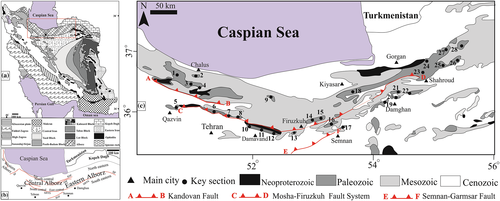
3 LITHOSTRATIGRAPHY
The Mississippian rocks of the central Alborz were included in two formations, Mobarak and Dozdehban. The former consists of black fossiliferous limestone with marl and black shale in the lower beds, which are equivalent to Members B–D of the Geirud Formation of Assereto (1963; Figure 2). Thus, the currently accepted Geirud Formation only corresponds to Member A of the Geirud Formation sensu Assereto (1963; Bozorgnia, 1973; Gaetani et al., 2009; Stöcklin & Setudehnia, 1991). The Mobarak Formation in south-central Alborz (Mobarakabad, Geirud, and Abnak areas) is mostly represented by a succession of marly and black shale interbedded with thin-bedded, clayey crinoid- and brachiopod-bearing limestone, dolomitic limestone, and medium- to thick-bedded ooidal limestone (Figure 2; Assereto, 1963; Brenckle et al., 2009; Najafi, 2001; Zandkarimi, 2017). In the east-central Alborz (Aieneh-Varzan Anticline, eastern Damavand City), it shows significant lithological variations (Figures 1-3) so that the lower marly and shaly parts are missing or are very thin (Abadi, Kulagina, & Voeten, 2017; Payami-e Rad, 2012; Zandkarimi, 2017). The Mobarak Formation of the north-central Alborz has a relatively different lithology compared with that of type area, in south-central Alborz. Consequently, it starts with thick- to very thick-bedded limestone, followed by thin- to medium-bedded occasionally sandy limestone and upper thick-bedded fetid ooidal limestone alternating with the blackish shale (Figures 2 and 3; Mosaddegh, 2000; Zandkarimi et al., 2016; Zandkarimi, Vachard, Cózar, et al., 2017; Zandkarimi, Vachard, Najafian, et al., 2017).
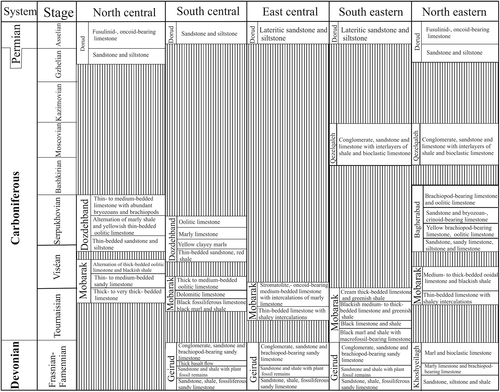
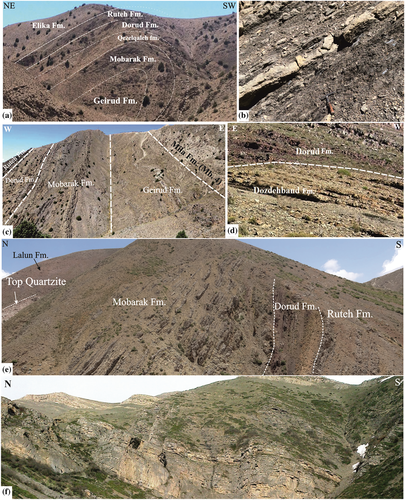
Towards the south-eastern Alborz, the Semnan and Damghan areas, the Mobarak Formation mainly consists of lower marl and shale with macrofossil-bearing limy intercalations and upper medium- to thick-bedded limestone (Abadi et al., 2017; Mosaddegh, 2000), indicating high resemblance to that of east-central Alborz, despite the absence of the uppermost Viséan ooidal lower unit (Figure 2). There are a few data about the lithology of the Mobarak Formation in the north-eastern Alborz. Therefore, more detailed studies recently carried on the same formation of the Tilabad section (Khoshyeilagh area, Shahroud City) considered it to include lower thin-bedded limestone and shale, middle thin- to medium-bedded limestone with dark shale, and upper thick- to medium-bedded limestone (Figures 1 and 2; Saeidi et al., 2012).
The central Alborz also contains a mixed siliciclastic–carbonate unit named by Bozorgnia to the “Dozdehban Formation.” This unit indicates facies and age variations towards the Caspian Sea, such that in the Jajrud valley, the type section of the Dorud Formation, it is represented by more siliciclastic content (Bastami, 2017). Northward it tends to show more carbonate content in the Valiabad, Dozdehban, and Naserabad sections (Figure 4). The thickness also increases in the same trend, 55 m in Jajrud (Bastami, 2017), 80 m in Valiabad (Zandkarimi et al., 2016), 110 m in the Dozdehban, and 128 m in Naserabad (Zandkarimi, Vachard, Cózar, et al., 2017; Figure 4).
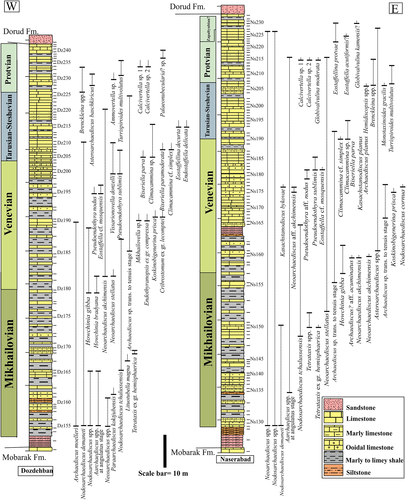
The north-eastern Alborz, around Ramian, contains a relatively similar Mississippian succession (Late Viséan–Early Bashkirian) as the north-western Alborz, referred to by Stampfli (1978) as the “Bagherabad Formation” (Figure 2). The formation is time equivalent of the Member 1 of the Qezelqaleh Formation of Jenny et al. (1978) in the south of Aliabad City, north-eastern Alborz.
There are significant lithological variations of Mississippian rocks between central, south-eastern, and north-eastern Alborz. As mentioned above, the Mobarakabad area, south-central Alborz, contains lower marl, middle dolomitic limestone, and upper oolitic limestone (Figure 2). Towards east-central Alborz, eastern Damavand City (Aieneh-Varzan Anticline), the lower marl unit becomes very thin or even is missing (Figure 2; Abadi et al., 2017; Payami-e Rad, 2012; Zandkarimi, 2017). Moreover, the oolitic limestone that is characteristic of the northern Alborz is not observed in the east-central and south-eastern Alborz (Abadi et al., 2017; Brenckle et al., 2009; Mosaddegh, 2000; Zandkarimi, 2017). The Mississippian rocks of the north-eastern Kiyasar area (Falahatgar & Mosaddegh, 2012) and most north-easterly areas of the Alborz (eastern Gorgan City, Tilabad; Jenny et al., 1978; Lys et al., 1978; Saeidi et al., 2012) show lithological and facies resemblances to the north-central Alborz and significantly different from the southern flanks (Figure 2).
The southern Alborz emerged after the Tournaisian and experienced nondeposition up to the Early Permian (Figures 5 and 6). Furthermore, in some areas such as Semnan (Shahmirzad and Peyghambaran sections), the sedimentary gap persists through the Triassic (Habibi et al., 2008). Hence, the Triassic Elika Formation overlies the Tournaisian Mobarak Formation with a lateritic contact (Habibi et al., 2008; Mosaddegh, 2000; this study). The east-central Alborz (eastern Damavand) displays very thin Mobarak and Lower Permian Dorud formations, as well as an absence of the Upper Permian Nesen Formation (Figure 3e).
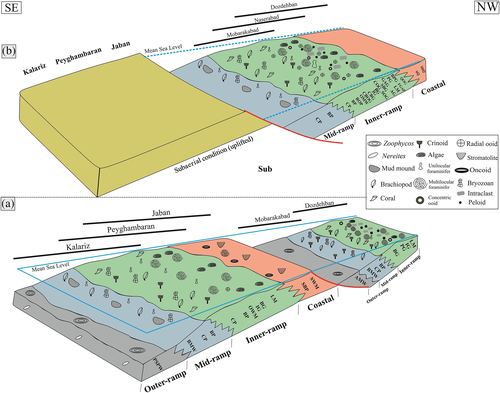
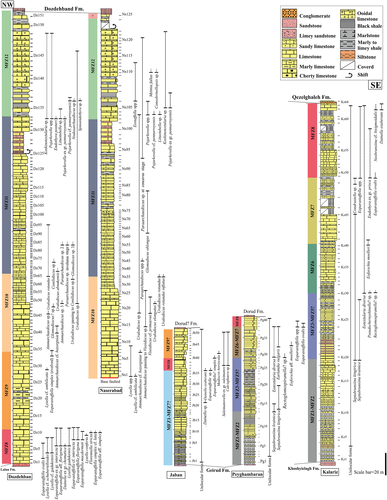
On the other hand, the half-graben structure can be dominated in this extensional environment with potential normal basement faults inherited from Early Palaeozoic rifting or even older (Butler, Tavarnelli, & Grasso, 2006; Ehteshami-Moinabadi et al., 2012; Ehteshami-Moinabadi & Yassaghi, 2007; Kearey, Klepeis, & Vine, 2008; Rossetti et al., 2017), resulting in nondeposition or less deposition on the horst and formation of thick and more complete strata in the subsiding graben. The effects of syn-sedimentary active faults in Alborz were previously pointed out by several workers (Ehteshami-Moinabadi, 2014; Yassaghi & Abassi, 2005; Yassaghi & Naeimi, 2011). Indeed, during the Late Palaeozoic, the southern flanks of the Alborz acting as a horst were partly experiencing continental conditions, indicated by the presence of lateritic soils, lack or very thin sequence of Upper Palaeozoic rocks, and northern Alborz as a large graben preserved the thickest and most complete strata of Late Palaeozoic age of Alborz. The possible tectonic boundary could be the Mosha–Firuzkuh fault system (or Abyek–Firuzkuh–Shahroud fault system sensu Nabavi, 1976). The key sections along this fault are the Jaban and Mobarakabad sections (Figure 1), of which the former (south of the Mosha–Firuzkuh fault system) has very thin Tournaisian shallow water limestones, followed by a few meters of Lower Permian rocks (Figure 3e). In contrast, the Mobarakabad section contains a very thick outer, middle, to inner ramp Upper Tournaisian–Lower Viséan limestones underlying the Upper Viséan–Serpukhovian Dozdehban Formation and a thick Permian succession including the Dorud, Ruteh, and Nesen formations (Mosaddegh, 2000). The same can be followed in the Firuzkuh area where the Kahanag section (Falahatgar et al., 2015) contains Upper Palaeozoic rocks resembling the Jaban section. Moving northwards of the Kahanag area, the Gaduk section exhibits a relatively complete and thick Upper Palaeozoic succession (Najafi, 2001). A similar scenario exists between north-eastern and south-eastern areas. In the south-eastern Alborz, there are several well-exposed Upper Palaeozoic rocks such as the Kalariz (Bozorgnia, 1973), Abrendan (Bahrammanesh et al., 2011; Brenckle et al., 2009), Simeh Kuh (Bahrammanesh et al., 2011), and Labnesar (Abadi et al., 2017; Kalantari, 1998) sections (Figures 1 and 2). The Mobarak Formation also contains Tournaisian marl and limestone capped by the Dorud Formation with a disconformity. On the other hand, moving northward, in the Shahroud and eastern Gorgan, the lithology changes again with more calcareous content (Figures 1 and 2). The thick and most complete Upper Mississippian–Early Pennsylvanian is observed in these areas (for more information, see Alipour et al., 2013, and Gaetani et al., 2009). The same was reported from the Toyeh section (Gaetani et al., 2009), whereas the south-eastern parts lack the Upper Mississippian (or are very thin), Pennsylvanian, and Permian rocks with low thickness overlie the Mobarak Formation (Bastami, 2017). Noteworthy is that this lithological variation is associated with age and facies variations across the northern and southern Alborz (see below). These sharp lithological, facies, and age variations are assigned to E–W trending basin-bounding faults.
4 MICROFACIES AND SEDIMENTARY ENVIRONMENTS
Lasemi and Mahari (1993) were first to consider that the Mobarak Formation was mainly deposited in a very shallow sea, supratidal, intertidal, lagoonal, and sandy shoal at east-central Alborz. Lasemi and Mosaddegh (1999) carried out comprehensive studies on the depositional environment of the Alborz. Lasemi considered that the Mobarak Formation formed in outer, middle, to inner ramp settings. The same author placed the south-eastern Alborz flanks as the deeper settings, changing to the east-central Alborz (the Arou section) into shallower water. These results were confirmed by Abadi et al. (2017).
The lower part of the Mobarak Formation in the south-eastern Alborz is mostly deposited in the outer ramp, as evidenced by microfacies of peloidal, spiculitic wackestone, argillaceous burrowed mudstone/wackestone, and peloidal wackestone (Figure 5). The middle ramp microfacies including bioclastic wackestone/mudstone, ostracod mudstone/wackestone, and middle to inner ramp consist of crinoid packstone and bioclastic packstone, which are mostly characteristic of the middle part of this formation. These microfacies are associated with organic-rich beds with abundant brachiopods and corals. The uppermost Tournaisian beds in the Peyghambaran and Kalariz sections mainly comprise shoal microfacies, bioclastic and intraclastic grainstones, and lagoonal microfacies, aggregate grainstone, green algal grainstone, and bioclastic packstone/grainstone (Figure 5). However, the upper beds of this formation in the Jaban section contain microfacies of sandy mudstone/wackestone, lime mudstone, oncoid packstone, and peloidal wackestone suggesting deposition on tidal flat environments (Figure 5). The Upper Tournaisian rocks in the Dozdehban section are mostly composed of intraclastic and bioclastic grainstones and coated bioclastic grainstone (Figure 5). However, their time equivalents in the Mobarakabad (Mosaddegh, 2000) and Abnak (Najafi, 2001) sections contain deeper middle to inner ramp association characterized by bioclastic wackestone/mudstone, crinoid packstone, and bioclastic packstone with relatively high organic and clay content as well as fragmented brachiopods and corals. Consequently, there is a break in the shallowing pattern of the same formation from south-east to east-central Alborz. As a result, in the Jaban section, these rocks are mostly represented by the tidal and shallowest facies, whereas the more northerly situated sections, such as the Dozdehban and Valiabad, show more distal settings (Figure 5). This is due to the effects of the inherited basement and syn-sedimentary fault movements, especially the Mosha–Firuzkuh fault system that is also associated with a significant thickness (see Section 3) and age variations (see Section 5) between the Upper Palaeozoic rocks of different localities. This fault has probably created a half-graben style and structural highs with different rates of subsidence and uplift. The examples of Carboniferous platforms controlled by syn-sedimentary faults were already provided by researchers such as Gawthorpe (1986) in northern England and Somerville et al. (2009) in north-west Ireland.
During the Early Viséan, most of south-eastern Alborz and east-central Alborz emerged, leading to nondeposition in these areas, whereas parts of south-central (Abnak, Geirud, and Mobarakabad sections) and north-western Alborz (Valiabad, Dozdehban, and Naserabad sections) remained under marine deposition mainly containing thick quartz bioclastic and green algal grainstone, all of which being indicative of sandy shoals and other inner ramp settings (Figure 5). The Middle Viséan rocks are mostly characterized by the presence of shoal-originated oolitic grainstone as well as bioclastic packstone with abundant green algae and foraminifers and peloidal grainstone indicative of a deposition under lagoonal conditions. Upward, the lower beds of the Dozdehban Formation consist of thin-bedded pinkish iron-oxide bearing submature quartzarenite probably suggesting the effects of a tectonic movement during MFZ13, early Late Viséan (Zandkarimi, Vachard, Cózar, et al., 2017). This is confirmed by the lack of the early Late Viséan diagnostic foraminifers throughout all studied sections in Alborz (Zandkarimi, Vachard, Najafian, et al., 2017). Overlying these sandstones, the Late Viséan–Serpukhovian rocks mostly contain inner ramp facies represented by alternations of bioclastic grainstone, oolitic grainstone, foraminiferal green algal packstone, and quartz ooidal grainstone (Figure 5). Upper beds of the same strata especially in the Naserabad section are represented by crinoid and bryozoan packstone indicating relatively deeper marine depositional environment (Figure 5). The Viséan–Serpukhovian rocks are missing in the southern parts of the Abyek–Firuzkuh fault system (Figure 5). It has probably experienced uplifting and nondeposition from the Viséan to Early Triassic (see Section 3).
5 FORAMINIFERAL BIOSTRATIGRAPHY
We have used our data from five studied sections (Dozdehban and Naserabad in north-central Alborz, Jaban in east-central Alborz, and Peyghambaran and Kalariz in eastern Alborz) and those previously studied by several workers across the entire Alborz from south-east to north-west (Figure 1; Bozorgnia, 1973; Brenckle et al., 2009; Falahatgar et al., 2015; Lys et al., 1978; Najafi, 2001; Payami-e Rad, 2012; Saeidi et al., 2012; Vachard, 1996; Zandkarimi, 2017; Zandkarimi et al., 2016; Zandkarimi, Vachard, Cózar, et al., 2017; Zandkarimi, Vachard, Najafian, et al., 2017). Foraminiferal data collected from the Alborz have been compared with those of the stratotypic area in Belgium (Conil & Lys, 1964; Conil, Groessens, Laloux, Poty, & Tourneur, 1991; Devuyst & Hance in Poty, Devuyst, & Hance, 2006; Mamet, 1974), the former USSR (Gibshman, 2001, 2003; Kabanov et al., 2016; Kulagina, Gibshman, & Pazukhin, 2003; Nikolaeva et al., 2009; Kulagina, 2013; Vdovenko, 2001), England and Scotland (Conil, Longerstaey, & Ramsbottom, 1980; Cózar et al., 2008, 2010; Cózar & Somerville, 2004, 2012, 2013; Fewtrell, Ramsbottom, & Strank, 1981; Somerville & Cózar, 2005; Strank, 1981), and in Morocco (Cózar et al., 2011; Cózar et al., 2014; Cózar et al., 2016; Vachard & Berkhli, 1992; Vachard & Tahiri, 1991). We have identified Early Tournaisian to Late Serpukhovian biozones in the Alborz as follows:
5.1 Tournaisian
The biozonation in the Namur and Dinant basins has principally been defined by using foraminifers, corals, and conodonts (Conil & Lys, 1964; Conil et al., 1980; 1991). Recently, Devuyst and Hance in Poty et al. (2006) revised the biozonation scheme and established a relatively comprehensive scheme for the latest Devonian to Late Serpukhovian, though some Late Viséan biozones have remained disputable (Cózar & Somerville, 2006; Somerville, 2008). Here, the Tournaisian biozones (MFZ1–MFZ8) are described.
5.1.1 Early Early Tournaisian: Hastarian
Unilocular zone (MFZ1–MFZ2?)
This zone is characterized by unilocular and bilocular foraminifers especially earlandiids and parathuramminids. No representatives of the more advanced foraminifers Chernyshinella and Tournayella have been still reported from this zone (Bozorgnia, 1973; Brenckle et al., 2009; Falahatgar et al., 2015; Vachard, 1996). We identified the foraminifers Diplosphaerina sp., Eotuberitina reitlingerae, Earlandia sp., Earlandia elegans, Earlandia ex gr. minor, Bisphaera irregularis, and Bisphaera sp. (Figure 7). Other foraminifers reported by Bozorgnia (1973), Kalantari (1998), Mosaddegh (2000), and Falahatgar et al. (2015) include Earlandia minima, Archaesphaera magna, Archaesphaera minima, and Radiosphaera sp. Noteworthy is that this biozone is only divided in south-eastern Alborz (Semnan and Damghan areas; see Figure 1). Although the unilocular zone coincides with MFZ1, due to lack of the MFZ2 materials and overlying Septabrunsiina krainica Zone (MFZ3), this zone is considered to span MFZ1 and MFZ2 intervals. Low abundance of foraminifers and absence of other diagnostic microfossils of Early Tournaisian age has been linked to unfavourable ecology by Bozorgnia (1973). It is confirmed by outer to middle ramp depositional environment in the lower beds of the Mobarak Formation in the eastern Alborz, in which foraminifers are relatively rare (see Section 4).

5.1.2 Late Early Tournaisian–Late Tournaisian: Late Hastarian–Ivorian
Septabrunsiina krainica Zone (Undivided MFZ3–MFZ5 interval)
The base of the zone is characterized by the FO of Septabrunsiina krainica and its top by the FO of Eotextularia diversa (Figures 6, 7, and 8). The FO of the former species is reported to be associated with occurrence of Palaeospiroplectammina tchernyshinensis, which is a diagnostic taxon of MFZ3 (Kalvoda, Kumpan, & Bábek, 2015). This zone with rare foraminifer occurrence is due to an unfavourable depositional setting (see Section 4). In addition to foraminifers observed in the unilocular zone, Septabrunsiina kingirica and Septabrunsiina spp. are added in the overlying beds. Upper beds of this zone contain Earlandia vulgaris and Granuliferella? sp. Rare occurrences of foraminifers do not permit further subdivision of this interval. This zone has been only recognized in the Peyghambaran and Kalariz sections. Bozorgnia (1973) reported this zone in the Firuzkuh surroundings, that is, the Arou and Gaduk sections. However, in some localities, such as the Jaban (Payami-e Rad, 2012; this study) and Kahanag (Falahatgar et al., 2015) sections, this zone also is not recognized, and the MFZ1–MF5 interval has been assigned to the lower part of the Mobarak Formation. This difference can be related to either differential uplifting or depositional environment.
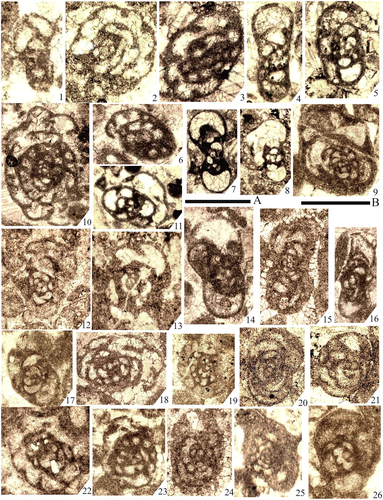
Eotextularia diversa Zone (MFZ6)
This zone is defined by the FO of Eotextularia diversa and is limited by the FO of Darjella monilis. The FO of the former species is an auxiliary for recognizing the MFZ6. In Belgium, the MFZ6 is named as the Tetrataxis Zone due to FO of the genus Tetrataxis. However, this genus is of doubtful occurrence in Alborz because it first occurs later, during the Late Tournaisian or Early Viséan (Falahatgar et al., 2015; Mosaddegh, 2000). MFZ6 corresponds to the first pulse in diversity and abundance of Tournaisian foraminifers in the Alborz. Pseudochernyshinella? sp., Rectoseptaglomospiranella? sp., Endothyra aff. apposita and Endothyridae indet. appear simultaneously with entry of E. diversa (Figures 6, 7, and 8). The upper beds of this zone record important occurrences of Eoforschia species. It is highlighted that the latter species is of rare occurrence in the Alborz Mountains and is not observed in all sections. It is reported from Arou (Bozorgnia, 1973), Kahanag (Falahatgar et al., 2015), and Kalariz (this study) sections. However, in some sections such as Peyghambaran and Shahmirzad, where D. monilis is not recorded, the undivided MFZ6–MFZ7 interval zone is proposed. Here, the top is defined by the entry of primitive Eoparastaffella spp.
Darjella monilis Zone (MFZ7)
This zone is based on the entry of Darjella monilis, which is rapidly followed by FO of Spinoendothyra sp., Pseudolituotubella sp., Tournayellina sp., Endospiroplectammina spp., Vissarionovella sp., and Brenckleites? sp. (Figures 6 and 9). The genera Condrustella and Elevenella appear in the top of this zone. It seems that this zone is of narrower occurrence in the eastern Damavand sections. In our material, Darjella monilis with low abundance is only recorded from the Kalariz section. Low abundance of this species is probably due to the fact that it is highly specialized and not able to adapt to the abrupt changes in environment conditions (Devuyst & Hance in Poty et al., 2006). Sporadically, the elements of MFZ6 such as Dainella sp., Eoforschia aff. moelleri and Eotextularia diversa can be observed in this zone.
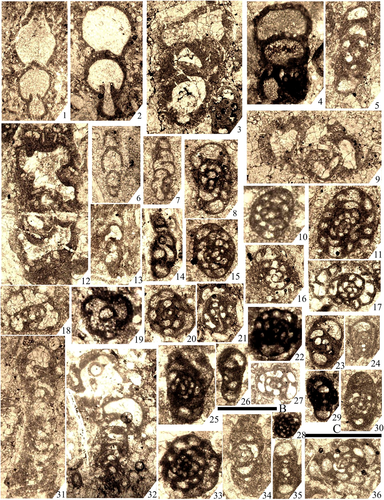
This zone is defined in the Kahanag (Falahatgar et al., 2015) and Kalariz (this study) sections.
Eoparastaffella Zone (MFZ8)
The zone is defined here by FO of primitive Eoparastaffella, especially E. ovalis. These species are followed by E. rotunda and E. interiecta (Figures 6 and 11), which are used as auxiliary taxa for recognition of this zone (Devuyst & Hance in Poty et al., 2006; Devuyst & Kalvoda, 2007). One of the important markers of this zone is supposed to be Lysella especially L. gadukensis (Devuyst & Kalvoda, 2007). Nevertheless, Bozorgnia (1973) assigned its FO in the Viséan rocks. Considering the revisions carried out on the Tournaisian–Viséan boundary and also the co-occurrence of Dainella chomatica (Kulagina et al., 2003), this genus first occurs in the middle part of MFZ8 in the Alborz. In fact, our specimens of the group D. chomatica occur several meters below the entry of Eoparastaffella simplex, thus indicating a latest Tournaisian age (Figures 6 and 11). The Daniella chomatica Zone of Bozorgnia (1973) apparently contains MFZ8 and MFZ9 (Figure 10) due to the presence of diagnostic foraminifers of these zones such as Eoparastaffella simplex ovalis (E. simplex for us (and various species of Dainella and Lysella that are widespread during the MFZ8 and MFZ9. The MFZ8 corresponds to second phase of diversification and abundance of foraminifers especially in central Alborz (Bozorgnia, 1973; this study). In general, the Tournaisian foraminifers in the Jaban section are rare and only appeared in a few levels. Here, the MFZ8 mainly contains Lysella sp., Dainella exuberans, Florennella sp., and Parabiseriella sp. (Figures 6 and 13). The eastern Alborz contains less diversified foraminifers, which in addition to Eoparastaffella spp. are represented by Dainella exuberans, Neobrunsiina cf. bisigmoidalis, Dainella spp., and Mediocris spp. (Figures 6 and 9). Other important taxa that mainly appeared in the Dozdehban section include Eoparastaffella ex gr. interiecta, E. aff. florigena, E. macdermoti, E. cf. interiecta, Endothyra ex gr. prisca, Lysella conferta, L. cf. gadukensis, L. cf. schubertelloides, L. schubertelloides, L. cf. umbilicata, Florennella stricta, Bessiella? sp., Eogloboendothyra? sp., and Inflatoendothyra sp. (Figures 6, 10, and 11).

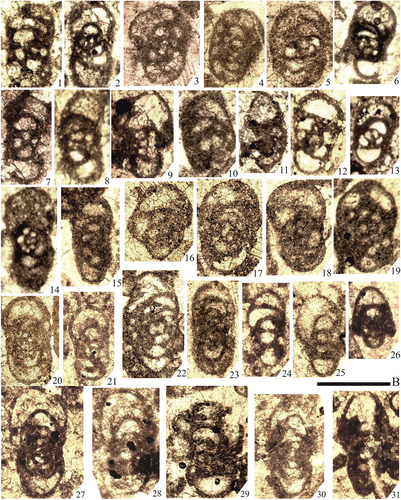
5.2 Viséan
Initial biostratigraphic works in the type and reference areas using foraminifers were carried out by Conil and Lys (1964), Conil, Groessens, and Pirlet (1977), and Conil et al. (1991), which were finally revised by Devuyst and Hance (in Poty et al., 2006). Devuyst and Hance (in Poty et al., 2006) divided the Viséan into the MFZ9–MFZ15 foraminiferal zones. The base of this stage has been located at the first occurrence of Eoparastaffella simplex, and its top is coincident with the FO of the conodont Lochriea ziegleri (Ogg, Ogg, & Gradstein, 2016). Although recent studies indicate that the FO of the latter species is not consistent with the base of the Serpukhovian, it has been reported in the underlying Venevian substage, uppermost Viséan (Cózar & Somerville, 2016; Gibshman et al., 2009; Kabanov, Alekseeva, & Alekseev, 2012).
5.2.1 Early Viséan: Moliniacian
Eoparastaffella simplex Zone (MFZ9)
This zone is characterized by entry of the index foraminifer Eoparastaffella simplex and is limited at the top by the FOs of primitive archaediscids. Eoparastaffella simplex is only reported from central Alborz (Bozorgnia, 1973; Devuyst & Kalvoda, 2007; Zandkarimi et al., 2016) probably due to the absence of the Viséan sediments in the south-eastern Alborz and lack of more comprehensive studies in north-eastern Alborz. Transitional forms between Eoparastaffella and Eostaffella are also observed in the middle part of this zone in the Dozdehban section (Figures 6 and 11). The FOs of Lapparentidiscus bokanensis and Brunsia pulchra also occur near the base of this zone. Some of representatives of this zone such as Lysella (L. conferta and L. umbilicata) and Dainella species extend into this zone (Figure 12). In the Jaban section, in spite of several field campaigns and numerous thin section preparations, only a questionable Eoparastaffella simplex (Figure 13) has been found in the upper beds. Furthermore, in the same strata, some specimens of Calcisphaera laevis (Figures 6 and 13) have been identified, which are common during the MFZ9 zone. The studies carried out on this area (i.e., in the Aieneh-Varzan Anticline) mostly considered MFZ8 for the upper beds of Mobarak Formation (Abadi et al., 2017; Mosaddegh, 2000). On the other hand, the MFZ9 zone is reported from the Kalmard block, Central Iran (Vachard & Arefifard, 2015).
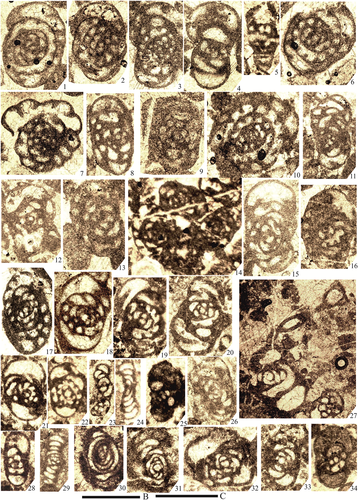
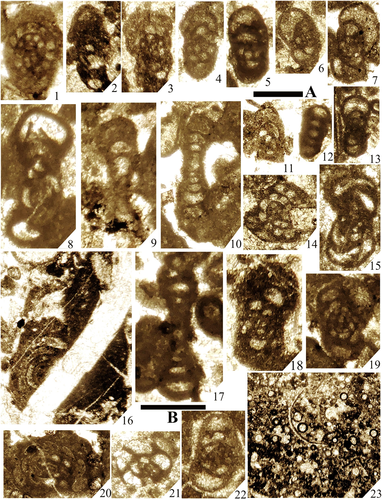
Primitive archaediscids Zone (MFZ10)
This zone is characterized by FO of the primitive archaediscids such as viseidiscid indet., ammarchaediscid indet., Ammarchaediscus sp. 1, A. sp. 2, A. sp. 3, A. sp. 4, and Ammarchaediscus passing to Viseidiscus sp. (Zandkarimi et al., 2016; Zandkarimi, Vachard, Najafian, et al., 2017). Top of this zone also records the genera Uralodiscus, Glomodiscus?, and Planoarchaediscus. Some specimens of archaediscids showing gradual change from planispiral to glomospiral coiling are recorded within this zone (Zandkarimi, Vachard, Najafian, et al., 2017). Other foraminifers are very rare in this zone, which includes Mediocris spp., Eoforschia subangulata, Eoforschia sp., Mediendothyra spp., and Endothyra spp. (Figure 14; Zandkarimi et al., 2016; this study).
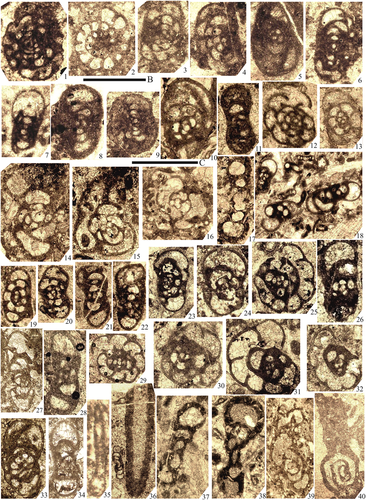
This zone is comparable with the lower part of the Permodiscus rotundus–Paraarchaediscus rigens Zone (Bozorgnia, 1973), the lower part of the Uralodiscus rotundus Zone (Kulagina et al., 2003), and equivalent to the Bobrikian Platform of the Russian Platform and the Middle Moliniacian of Belgium.
Uralodiscus rotundus Zone (MFZ11)
The lower boundary is defined by the FO of Uralodiscus rotundus and its upper boundary by the FO of the genus Pojarkovella (Devuyst & Hance in Poty et al., 2006). This zone contains a number of archaediscoids with test being in ogival stage such as Uralodiscus rotundus, U. elongatus, and in the upper beds of zone U. abnakensis (see Zandkarimi, Vachard, Najafian, et al., 2017). The genus Conilidiscus that determines the MFZ11b zone in Turkey (Okuyucu, Vachard, & Göncüoğlu, 2013) appears in the middle part of the zone. Upper beds of this zone record the FO of Nodosarchaediscus and Paraarchaediscus at the concavus stage. Maximum abundance of the Uralodiscus and Glomodiscus is observed in the middle part of this zone, whereas primitive archaediscids become rare in the upper beds (Zandkarimi, Vachard, Najafian, et al., 2017). This zone were locally divided into MFZ11A and MFZ11B (Zandkarimi et al., 2016), but the bioevent used for such a subdivision cannot be identified everywhere. Non-archaediscids are rare in this zone and mainly represented by Mediendothyra spp., Eostaffella spp., Endothyranopsis compressa, Omphalotis cf. minima, dainellid indet., and Endothyra similis (Figure 14). This zone corresponds to the Bobrikian substage in the Russian Platform (Lipina & Reitlinger, 1970), the upper part of the Moliniacian in the western part of Europe and the upper part of the Permodiscus rotundus–Paraarchaediscus rigens Zone of Bozorgnia (1973; Figure 10).
5.2.2 Middle Viséan: Livian
Pojarkovella–Koskinotextularia Zone (MFZ12)
This zone is determined with the FO of the genus Pojarkovella, especially P. pennarroyensis. In the Naserabad and Dozdehban sections, simultaneously with the first appearance of this genus, the genera Lituotubella and Koskinotextularia appear and serve as auxiliary taxa in this zone (Devuyst & Hance in Poty et al., 2006). Other important species identified in the studied sections are Pojarkovella cf. pennarroyensis, Mstinia fallax, Endothyra posneri, and Spinoendothyra sp. (Figures 6 and 15). Mstinia fallax and Endothyra posneri are reported from the MFZ12 of Belgium (Conil et al., 1991) and South China (Hance et al., 2011). It should be noted that, despite numerous thin sections, the most important species of this zone, P. nibelis, is not seen in the Dozdehban and Naserabad sections. It was reported for the first time from the MFZ12 of Valiabad (Zandkarimi et al., 2016). Among the archaediscids species that appeared in this zone for the first time, we can refer to Nodosarchaediscus, Paraarchaediscus ex gr. stilus, Paraarchaediscus aff. koktjubensis, and Paraarchaediscus spp. at the concavus-angulatus stage, which are of local importance for determining this zone (Zandkarimi, Vachard, Najafian, et al., 2017).
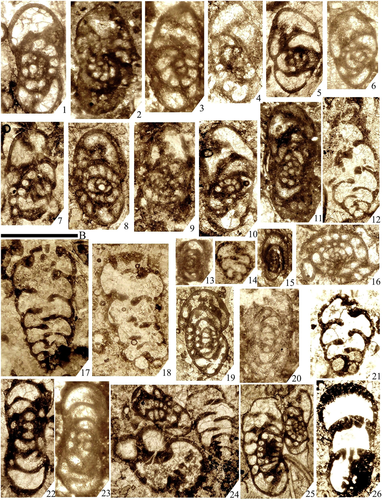
It is noteworthy that this zone corresponds to the lower part of the Rugosoarchaediscus–Endothyra omphalota–Archaediscus convexus Zone of Bozorgnia (1973), although no species of Pojarkovella was reported by the latter author. The genus Rugosoarchaediscus is considered as a synonym of Neoarchaediscus (Miklukho-Maklay, 1956), because of the lumina of its type species Archaediscus akchimensis, initially stellate and then free of nodosities (Cózar et al., 2014; Loeblich & Tappan, 1987; Zandkarimi, Vachard, Cózar, et al., 2017). It should be noted that some Rugosoarchaediscus of Bozorgnia (1973) rather correspond to Nodosarchaediscus (see Plate XX: figs 4 and 9–12 and Plate XXII: figs 5, 6, and 8–10 of Bozorgnia, 1973; Somerville, 2008; Vachard, 1988; Zandkarimi, Vachard, Cózar, et al., 2017). Najafi (2001) reported a Late Tournaisian to Middle Viséan age for the Mobarak Formation in the Abnak section. The main diagnostic foraminifers for such an age assignment were Omphalotis minima and Rugosoarchaediscus (= Nodosarchaediscus), although the upper beds contain an assemblage of foraminifers misinterpreted as Endothyra sp. (Plate 4, figs 3–8 of Najafi, 2001), which in fact correspond for us to Pojarkovella ketmenica and P. wushiensis. The Mobarak Formation of north-eastern Alborz ends in MFZ12 due to the records of Nodosarchaediscus demaneti and Koskinotextularia spp. (Saeidi et al., 2012). This zone corresponds to the Livian of Western Europe and the Tulian of the Russian Platform (Figure 10).
5.2.3 Late Viséan
The Late Viséan has been divided into MFZ13, MFZ14, and MFZ15 foraminiferal zones by Devuyst and Hance (in Poty et al., 2006). Due to the problems of the Late Viséan zonation of Poty et al. (2006) already discussed by Vachard, Cózar, Aretz, and Izart (2016) and the lack of diagnostic foraminifers such as Janischewskina typica in our material, the Late Viséan to Serpukhovian zonation (MFZ14–MFZ16) of Poty et al. (2006) is not used herein. Instead, we have used the Russian Platform substages, which are more consistent with our data.
Early Late Viséan
No foraminiferal indicator of the early Late Viséan has been reported from Iran, though Bozorgnia (1973) considered his Rugosoarchaediscus–Endothyra omphalota–Archaediscus convexus Zone to span Middle Viséan to early Late Viséan. Nonetheless, the true markers of early Late Viséan such as Eostaffella proikensis and Archaediscus gigas cannot be seen in his material. The local Mstinia bulloides–Pseudoendothyra assemblage Zone of Zandkarimi et al. (2016) that was locally correlated to MFZ13 (Figure 10) does not contain any markers of early Late Viséan, actually spanning the Upper Middle Viséan (MFZ12) in the lower part and probably latest Aleksian substage of the Russian Platform due to the occurrence of Pseudoendothyra sp. Additionally, uppermost beds of the Mobarak Formation in Naserabad contain a single occurrence of this genus. Absence of the early Late Viséan (Aleksian substage) can probably be linked to a tectonic phase, which was referred to as the “Alborzian” phase by Aghanabati (2004). In this context, the iron-oxide bearing submature sandstones of the basal Dozdehban Formation can confirm the emergence of Alborz.
Neoarchaediscus Zone (Mikhailovian)
This zone is characterized by the FO of Neoarchaediscus and Kasachstanodiscus together with the acme of genera Archaediscus at angulatus stage, Nodosarchaediscus and Koskinotextularia (Zandkarimi, Vachard, Cózar, et al., 2017).
The first Late Viséan Neoarchaediscus–Howchinia gibba–Bradyina lucida Zone of Bozorgnia (1973) amended by Vachard (1996) to Neoarchaediscus stellatus–Howchinia bradyana–Bradyina rotula Zone belongs to the Late Mikhailovian–Middle Venevian due to most recent revisions in the Howchinia species (Cózar et al., 2015; for more discussions, see Zandkarimi, Vachard, Cózar, et al., 2017).
Howchinia gibba–Archaediscus angulatus-tenuis stage–Neoarchaediscus akchimensis Zone (Venevian)
This zone is based on the important occurrences of Howchinia gibba, Neoarchaediscus akchimensis, and Archaediscus spp. at the angulatus-tenuis stage. Among other auxiliary taxa, we can refer to Kasachstanodiscus bykovae, Vissarionovella donzelli, Pseudoendothyra nodus, and P. sublimis. The two latter species occurring in the upper part of the zone are mostly reported from the Late Brigantian of northern England (Somerville & Cózar, 2005).
The upper part of the Neoarchaediscus stellatus–Howchinia bradyana–Bradyina rotula Zone (Vachard, 1996) and the Asteroarchaediscus baschkiricus–Neoarchaediscus incertus Zone (Bozorgnia, 1973) belongs to the Venevian stage.
5.3 Serpukhovian
Serpukhovian strata yield abundant and varied fossil assemblages that have been studied extensively in Russia and the Ukraine (Aisenverg et al., 1979). The Viséan/Serpukhovian boundary has recently being a matter of debate (Cózar et al., 2011; Cózar & Somerville, 2014, 2016; Kabanov et al., 2012). Therefore, it coincides approximately with the occurrences of Archaediscus at tenuis stage and Eostaffella pseudostruvei (Cózar et al., 2011). However, none of these taxa have been observed in northern Alborz (Bozorgnia, 1973; Mosaddegh, 2000; Vachard, 1996; Zandkarimi et al., 2016; 2017); instead, as already used in England (Stephenson et al., 2010) and Morocco (Vachard & Berkhli, 1992; Vachard & Tahiri, 1991), we used the occurrence of Biseriella parva for the recognition of the boundary. It has been proved that the species can be a potential local marker for the recognition of this boundary (Cózar et al., 2011).
5.3.1 Biseriella parva–Climacammina Zone (Tarusian–Steshevian)
This zone is characterized by the presence of Biseriella parva and Climacammina spp. especially C. ex gr. simplex. Other important species are Endostaffella delicata, E. shamordini, E. sp. 1, and E. sp. 2. Furthermore, Biseriella paramoderata that due to rapid evolution can be of local importance for the definition of this zone (Zandkarimi, Vachard, Cózar, et al., 2017). This zone contains large Kasachstanodiscus planus and Archaediscus planus. Additionally, a significant change in archaediscids is reported in this zone represented by a large decrease in abundance of Nodosarchaediscus and Archaediscus at angulatus stage and disappearance of Glomodiscus (Zandkarimi, Vachard, Cózar, et al., 2017).
The Archaediscus baschkiricus–Neoarchaediscus incertus Zone of Bozorgnia (1973) can be regarded as a Tarusian age (Zandkarimi et al., 2017), because this zone contains Asteroarchaediscus postrugosus (now Neoarchaediscus postrugosus), which is a diagnostic foraminifer of the Viséan–Serpukhovian boundary (Gibshman, 2001, 2003). In north-eastern Alborz, an Eostaffella pseudostruvei–E. mirifica Zone (Vachard, 1996) was considered as a Late Serpukhovian in the middle beds of the Bagherabad Formation; nevertheless, both species are now considered as characteristic of the Early Serpukhovian (Cózar et al., 2008; Cózar et al., 2014).
5.3.2 Turrispiroides multivolutus–Brenckleina–Eostaffellina protvae Zone (Protvian)
This zone is defined by the co-occurrence of important taxa Turrispiroides multivolutus, Brenckleina, and Eostaffella protvae (Figure 10; Zandkarimi, Vachard, Cózar, et al., 2017). Some other important Late Viséan markers that occur for the first time in this zone are Eostaffellina actuosa?, Eosigmoilina spp., and Brenckleina rugosa. This zone contains some taxa such as Brenckleina and Eosigmoilina reported from the uppermost Early Serpukhovian (Cózar et al., 2008; Cózar et al., 2016; Cózar & Somerville, 2014), but which are more common during the Late Serpukhovian (Cózar et al., 2012; Cózar et al., 2014). Additionally, Eostaffellina protvae is indubitably a Protvian marker (Cózar & Somerville, 2016; Gibshman, 2003; Vdovenko, Aisenverg, Nemirovskaya, & Poletaev, 1990). This zone also records the LOs of Nodosarchaediscus, Archaediscus, and Paraarchaediscus (Zandkarimi et al., 2017).
Zandkarimi, Vachard, Cózar, et al. (2017) reported the Plectostaffella–Globivalvulina kamensis? Zone, which is questionably assigned to a Zapaltyubian age, latest Serpukhovian. The FOs of two mentioned taxa were reported to be associated with this stage (Cózar & Somerville, 2016).
The age variations of the Mississippian rocks across the Alborz that already mentioned by several workers such as Bozorgnia (1973), Vachard (1996), and Brenckle et al. (2009) were attributed to the various events such as the Mississippian glaciation phases (Brenckle et al., 2009). Our point of view is in agreement with that of Bozorgnia (1973) who proposed that the age variations have been caused by differential uplifting. It is probably triggered by the vertical movements along major syn-sedimentary faults. However, the age, facies, and thickness variations of lithostratigraphic units in the Alborz are not specific to the Mississippian and are reported during the entire Palaeozoic (Bayet-Goll, Chen, & Moussavi-Harami, R., & Mahboubi, A., 2015; Gaetani et al., 2009; Partoazar, 1995), even Mesozoic (Fürsich et al., 2009), and Cenozoic (Aghanabati, 2004). During these times, tectonic movements created different environments. Here, these variations are attributed to the inherited basement and syn-sedimentary E–W trending faults.
6 CONCLUSIONS
The new foraminiferal analysis on the five sections and revision of literature carried out in the Alborz allow to define five Tournaisian biozones Unilocular (Hastarian), Septabrunsiina krainica (Late Hastarian–Ivorian), Eotextularia diversa (Ivorian), Darjella monilis (Ivorian), Eoparastaffella (Ivorian); five Viséan biozones Eoparastaffella simplex (Moliniacian), primitive archaediscids (Moliniacian), Uralodiscus rotundus (Moliniacian), Pojarkovella-Koskinotextularia (Livian), Neoarchaediscus (Upper Mikhailovian), Howchinia gibba–Archaediscus/Paraarchaediscus at angulatus-tenuis stage–Neoarchaediscus akchimensis (Venevian); and two Serpukhovian biozones Biseriella parva–Climacammina (Tarusian–Steshevian) and Turrispiroides multivolutus–Brenckleina–Eostaffellina protvae (Protvian) for the Mississippian rocks of the Alborz. The results indicate age differences of the Mississippian rocks between the northern and southern flanks of Alborz. In eastern Alborz and eastern central Alborz (Kalariz, Peyghambaran, and Jaban sections), they are of Tournaisian age (MFZ1–MFZ8), whereas in northern Alborz, they are dated from the Late Tournaisian to Late Serpukhovian (MFZ8–MFZ16). The sedimentological studies show the considerable environmental changes, following the trend of age variation. In this context, south-eastern Alborz contains Tournaisian rocks with outer to middle ramp depositional setting, whereas the Tournaisian rocks of east-central Alborz (eastern Damavand town) mainly show middle to inner ramp settings. Immediately, towards the north, these rocks show a dramatic change in environment and thickness. Previously, the age variations of this formation were attributed to various events such as the Mississippian glaciation. However, the age, thickness, and facies variations of lithostratigraphic units are not specific to the Mississippian and are reported during the entire Palaeozoic and even Mesozoic and Cenozoic. We propose that due to the passive margin conditions of the Alborz and dominance of extensional tectonics, the evolution of Late Palaeozoic Platform of the Alborz was partly controlled by roughly E–W-trending inherited basement faults such as Mosha–Firuzkuh fault system and syn-sedimentary normal faulting. Small-scale variations of lithology might be controlled by local complex structures including full grabens, horsts, and half graben that ultimately become the position of accumulation of sedimentary deposits in the margin.
ACKNOWLEDGEMENTS
This research is the results of a PhD thesis of the first author who warmly appreciates the collaboration of his friends Masoud Oveisi, Javad Razmjooei, Ali Saeidi, and Mohsen Ghorbani and his brothers Madi-, Hadi-, and Sasan Zandkarimi in field campaigns over a 5-year interval. Dr. P. Cózar provided critical comments on the foraminifer identifications and zonations. Prof. Manuel Berberian suggested key notes about the tectonics of the Alborz. The field trips were partly supported by the Pars Geological Research Centre (Arianzamin). Thanks to the reviewers Drs. P. Cózar and J. Kalvoda and an anonymous reviewer for their corrections and suggestions on a first draft. Prof. I. D. Somerville (editor-in-chief) greatly improved the quality of the manuscript.



